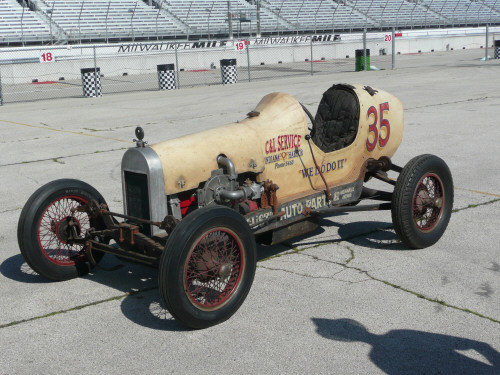Late 1920s Fronty Ford 88" dirt car
state of the art for the time period
|
|
I WONDER WHAT’S UNDER THIS TARP?
While seeking a set of wheels I stumbled upon this partially disassembled sprint car in Chicago. The car was an easy reassembly as the bolt holes all matched up. Some parts were missing and many were broken. The model T Ford block was OK but the oil pan was windowed. The cam cover was missing as well as parts of the chain cover. The scavenger pump for the dry sump system was a die cast piece and is unusable. The water pump was in pieces. A bunch of small parts such as linkages and bolts etc. were gone. Most of these missing and broken parts have been replaced by modifying some found parts or recasting some new pieces. Some cosmetic work has been done.
The car has an 88 inch wheel base. It sports 17 inch Dayton dental drive wheels in the rear and 18's in the front. The rear tires are 5.50 x17 Atlas Roadsters and the fronts are 4.50x18 ribbed Wards Riversides. The tires are screwed to the rims and there are weight bolts installed on the rears. The frame is a modified model T with adjustable truss bars along the bottom rails and is clad with a sheet metal cover. The rear end is an early mechanical brake Chevy and, as explained to me by Speedy Bill Smith, was used because the gears were much easier to change and the axels were full floating. The steering box is a Ross. The body maker is unknown. The Model T based engine is a dry sump supercharged SOHC dual spark SR Fronty swinging a Fronty counterbalanced crank. The chain driven supercharger is a Gregg that sucks through a 2 inch barrel valve Winfield carb. Spark is provided by a Bosch ZR4 twin spark magneto. The engine is coupled to a 1928 Model A transmission and clutch assembly.
I have no factual history on the car. I have received some suggestions as to the car's history, but I have nothing to back up the claims and I personally doubt most of the theories. Obviously what we have here is a very competitive dirt car from the late twenties and probably early thirties if it held together.
Notice the parting line between the 3 and the 5.
That indicates where the tail is actually nailed to the back of the body. It's a nailed on tail.
These photos were taken at the 100th anniversary of the Model T in Richmond, IN.
This is a Gregg supercharger which is described on page 173 of Dan R. Post's book The Model T Ford in Speed and Sport. It's mounted sidewinder style and is driven by double row chains through a 90 degree gearbox to the supercharger which runs at 6 times crankshaft speeds.
This is a 2 inch Winfield barrel valve carburetor which can be mounted as a downdraft, updraft, or sidedraft.
It's mounted this way because the carburetor linkage fits.
The dash has an oil pressure gauge, fuel pressure gauge, and a mag switch. When you turn the switch all the way to the left, it sends all the spark to the intake side spark plugs for starting. Straight up and down, the mag fires all 8 sparkplugs for racing. All the way to the right, shuts the engine off. These cars were pull started using a rope wrapped once around the axel and held by the driver. When the car fired the driver would release the rope while the tow vehicle pulled the rope away. The starting procedure was probably as dangerous as the race.

myself, "Speedy Bill" and my wife Margaret
at the 100th Anniversary of the Model T in Richmond, IN
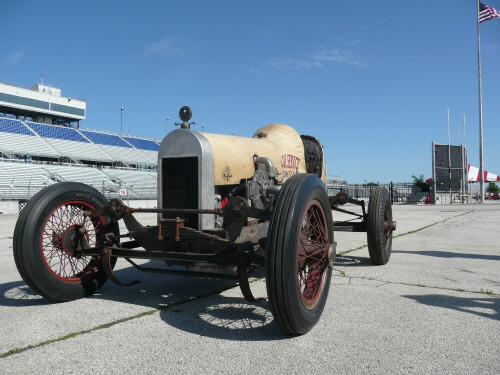
Here's the car standing tall at the Miller Meet at the Milwaukee Mile. Maybe this car was here in the late 20s. Notice the skids dropping down from the axel, they prevented the car from flipping over when a spindle broke or a front wheel fell off. The skids are one of two safety features on the car. The other being the St. Christopher medal on the dash.
Under hood details showing the double row chains driving the supercharger through a 90 degree gearbox and the pressure side of the supercharger with its pop off valve plumbed on top of a real SR Fronty intake manifold
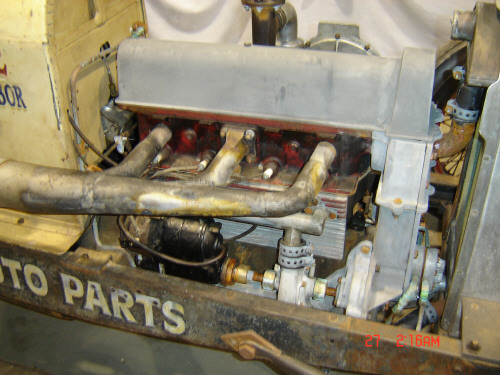
That's a Bosch ZR4 twin spark mag coupled to the waterpump spun by a gear drive from the crankshaft. The mag fires 8 sparkplugs on this 4 cylinder motor--4 on the intake side and 4 on the exhaust side. The two stage oil pump on the lower front cover feeds oil to the mains, rods, camshaft, and also pumps oil from the sump back up to a tank in the cowl.
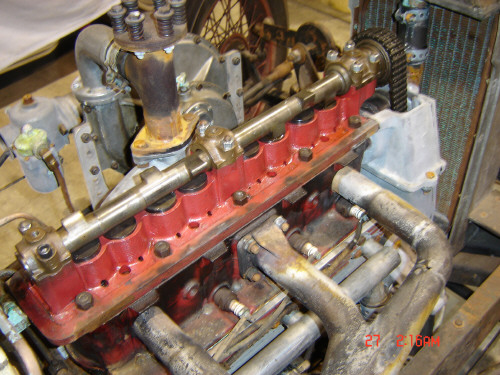
With the cam cover off you can see the chain driven Fronty overhead cam and cup system. The cam is drilled and pressure fed through the rear cam bearing and oil flows through the cam to the bearings and cups.
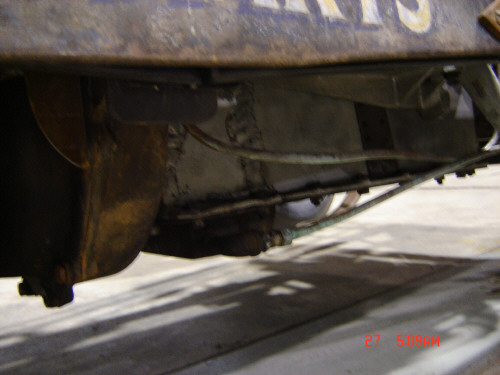
Worms eye view showing the Fronty oil pan with all its patches and welds--obviously used and abused. This pan enables a Model T block to be coupled to a Model A bellhousing, clutch,and sliding gear transmission assembly--the hot ticket on dirt in the late twenties and early thirties. Many of the race items on this car can be read about in Dan Post's Model T Ford in Speed and Sport starting on page 101.
